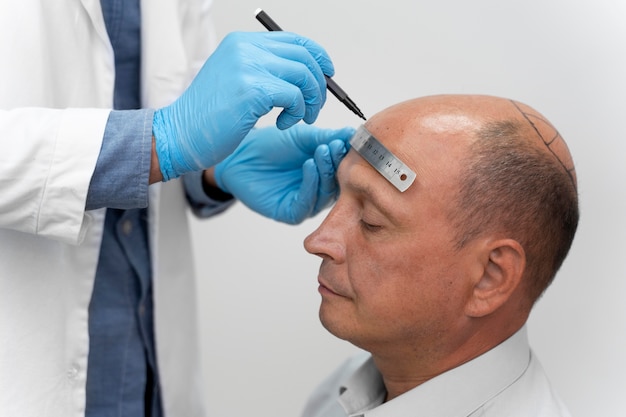FUE hair transplants, or Follicular Unit Extraction, have become increasingly popular for individuals seeking a solution to hair loss. This advanced technique offers a minimally invasive approach to restoring hair, making it more appealing than traditional methods. This article delves into what FUE Hair Transplants In Dubais are, the procedure involved, and what you can expect throughout the process.
Understanding FUE Hair Transplants
FUE hair transplants involve extracting individual hair follicles from a donor area, typically the back or sides of the scalp, where hair is denser. These follicles are then implanted into areas experiencing thinning or balding. Unlike traditional hair transplant methods, FUE does not require a large incision, resulting in less noticeable scars and a quicker recovery time.
The Benefits of FUE
One of the key benefits of FUE hair transplants is the minimal invasiveness of the procedure. Since it involves extracting individual follicles rather than a strip of scalp, patients experience less discomfort and a reduced risk of complications. Another significant advantage is the natural appearance of the results. Skilled practitioners can ensure that follicles are placed in a manner that mimics natural hair growth.
FUE is also versatile; it can be used to address various types of hair loss including androgenetic alopecia (male or female pattern baldness), traumatic hair loss, or thinning hair. Furthermore, patients often appreciate the fact that FUE can be performed under local anesthesia, allowing them to be awake during the process if they choose.
The FUE Procedure
Before undergoing an FUE hair transplant, patients typically have a consultation with a qualified practitioner. This meeting is essential for assessing the extent of hair loss, discussing expectations, and creating a personalized treatment plan. The consultation may include a review of medical history and a physical examination of the scalp.
On the day of the procedure, the first step is preparing the donor area. The hair in this region is trimmed to a short length, which facilitates the extraction process. Local anesthesia is then administered to ensure comfort during the procedure.
The extraction process begins with the practitioner using a specialized tool to remove individual follicles. This precision not only minimizes damage to surrounding tissues but also contributes to the quality of the harvested follicles. Once the follicles are extracted, they are carefully preserved in a solution to keep them viable until they are implanted.
After the extraction is complete, attention turns to the recipient area. The practitioner will create tiny incisions in the scalp where the follicles will be placed. The angle, depth, and direction of these incisions are crucial for achieving a natural look. Once the recipient sites are prepared, the hair follicles are implanted into the scalp.
Recovery from FUE Hair Transplant
Following the procedure, patients can expect a recovery period that typically lasts about a week. Initial discomfort may occur, which is generally manageable with over-the-counter medications. It's common for patients to experience minor swelling and redness in the treated areas. While some shedding of the transplanted hair can occur in the weeks following the procedure, this is expected and part of the natural growth cycle.
Patients are often advised to avoid strenuous activities and exposure to direct sunlight during the initial recovery phase. It’s also crucial to follow the practitioner’s post-operative care instructions carefully to support healing and maximize results.
Results of FUE Hair Transplants
One of the most exciting aspects of FUE hair transplants is that results are not immediate. Patients will notice hair growth gradually over several months. Typically, the transplanted hair will start to grow in about three to four months, with fuller results visible after six to twelve months. The newly grown hair will blend seamlessly with existing hair, providing a natural appearance.
It’s important to have realistic expectations about the results. While FUE can significantly improve the appearance of thinning or bald areas, the amount of hair required for a full restoration can vary based on individual factors such as hair type, density, and scalp laxity. Consultations with practitioners can help set those expectations accurately.
Long-Term Care and Maintenance
An often-overlooked aspect of FUE hair transplants is the importance of long-term care. While the transplanted follicles are permanent and should last a lifetime, it is crucial to maintain scalp health and address any ongoing hair loss in non-transplanted areas. Regular check-ins with a healthcare provider can help monitor hair health and discuss any additional treatments, such as medications that may support ongoing hair resilience and growth.
Who is an Ideal Candidate?
FUE hair transplants are suitable for various individuals, particularly those with stable hair loss patterns and sufficient donor hair. Factors such as overall health, hair type, and hair loss severity play a role in determining candidacy. Individuals with realistic expectations and a desire for a natural-looking solution to hair loss are often the best candidates for this procedure.
Conclusion
FUE hair transplants represent a significant advancement in the field of hair restoration, providing patients with an effective and natural solution to hair loss. By understanding what to expect before, during, and after the procedure, individuals can make informed decisions about their hair restoration journey. With proper care and attention, patients can achieve satisfying results that enhance their confidence and quality of life.





Comments